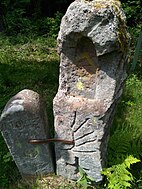Menhir (Brombach)
| Menhir (Brombach) | ||
|---|---|---|
|
The Brombach Menhir |
||
|
|
||
| Coordinates | 49 ° 29 '14.2 " N , 8 ° 51' 12.5" E | |
| place | Eberbach , OT Brombach , Baden-Württemberg , Germany | |
The menhir is a prehistoric menhir in Brombach , a district of Eberbach in the Rhine-Neckar region in Baden-Württemberg .
location
The stone is located west of Brombach in a wooded area, exactly on the municipality boundary with Heddesbach . It is accessible via a forest path, the Hinkelsteinweg.
description
The menhir is made of red sandstone . It is pillar-shaped and heavily worked on. The sides are heavily smoothed at the bottom, but the upper area is only roughly processed. On the facing Brombach side of the niche is above carved for receiving a Holy portrait, including a antler as a sign of centering Hirschhorn (popularly it is referred to as "Hinkel tail", ie, "Hünchenschwanz") and at the bottom of a isosceles cross as a sign of bishopric Speyer . The letters "HH" and "MIK" are carved on the side facing Heddesbach. The stone has a height of 170 cm, a width of 40 cm and a thickness of 40 cm. It is connected to a modern landmark with an iron clip.
The menhir in regional sagas
According to a legend , if you press your ear to the stone, you should hear the chickens cackling underneath. The legend probably has its origin in the name Hinkel for a young chicken . However, there was also the medieval custom of placing eggshells, broken glass and coals under a boundary stone in order to see if the stone was lifted whether it was legal.
A related legend reports that some people saw a young hen ("Hinkel") near the menhir, which did not belong to anyone and which could not be caught but always disappeared under the stone.
Another legend revolves around the use of the menhir as a boundary stone. Accordingly, the residents of Brombach and Heddesbach had agreed to resolve their border dispute in such a way that a giant named Hinkel, who lived in the area, should carry a sandstone block near Heddesbach towards Brombach. He was even allowed to rest once on the way, but then the place where he put the stone from exhaustion should mark the boundary between the two places. The giant agreed, made his rest on a stone block near Heddesbach, which is therefore called the Ruhestein, and finally put the menhir down at its current location.
literature
- Otto Gödel: Menhirs - a scientific and folkloric contribution to our stone monuments. In: Communications of the Historical Association of the Palatinate. Volume 96, 1998, p. 41.
- Johannes Groht : Menhirs in Germany. State Office for Monument Preservation and Archeology Saxony-Anhalt, Halle (Saale) 2013, ISBN 978-3-943904-18-5 , pp. 75, 88.
- Horst Kirchner: The menhirs in Central Europe and the menhir thought (= Academy of Sciences and Literature. Treatises of the humanities and social sciences class. Born 1955, No. 9). Wiesbaden 1955, p. 144.
- Friedrich Mößinger: wayside shrines in the Odenwald (= writings for local history and home care in the Starkenburger area. Volume 28/29). Verlag der Südhessische Post, Heppenheim 1962, p. 18.
Web links
- The Megalithic Portal: Menhir Brombach
- suehnekreuz.de: Brombach

